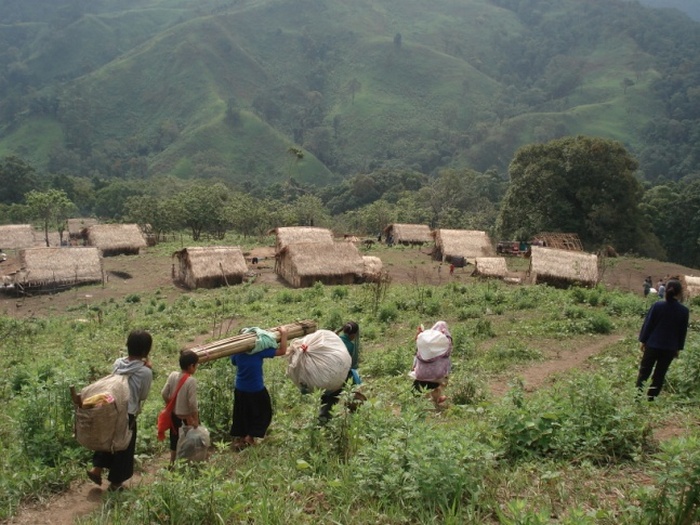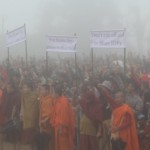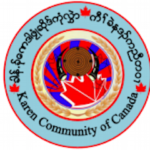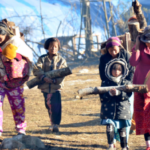Update by the Shan Human Rights Foundation (SHRF) | August 30, 2017
Summary
There are currently six camps along the Shan-Thai border, housing about 6,200 refugees (many of whom are categorized as “internally displaced persons” or IDPs, because they stay just inside the Shan border), 70% of these refugees are women and children.
These camps have existed for up to 18 years. Most of the refugees fled the Burma Army’s massive scorched earth campaign in central Shan State during 1996-1998, in which over 300,000 villagers were forced at gunpoint from their homes, and hundreds of villagers were tortured, raped and killed.
Denied the same recognition and access to aid as refugees from Karen, Karenni and Mon States, the refugees in camps on the Shan border have struggled for survival. Situated on remote mountaintop locations, with little cultivable land, and surrounded by Burma Army and United Wa State Army (UWSA) camps, the refugees have managed against all odds to rebuild their communities, setting up schools, health centres, and temples or churches.
This was possible due to the support of international donors, who have provided basic food supplies to the refugees for the past 18 years.
Unfortunately, this aid is about to end. As a result of the peace process in Burma, donors have moved their funds away from the border, and have announced they will cut off food aid for all six camps on the Shan-Thai border in October 2017.
In fact, the refugees in camps along the Thai-Shan border are still unable to return home. The Burma Army has not adhered to its ceasefire agreements, and has continued its military expansion and operations throughout Shan State. Civilians continue to face systematic abuse.
Hundreds of the original villages of the refugees lie derelict or are occupied by the Burma Army, government militia or UWSA. New mega projects planned by the Burmese government, against the wishes of local communities, threaten to permanently wipe out scores of villages.
Unless there is a genuine nationwide ceasefire, withdrawal of Burma Army troops, and a political settlement to end the civil war, the displaced villagers dare not return home.
Until such time as the refugees can return voluntarily, in safety and dignity, international donors are urged to maintain adequate humanitarian support for the refugee and IDP camps along the Shan-Thai border.
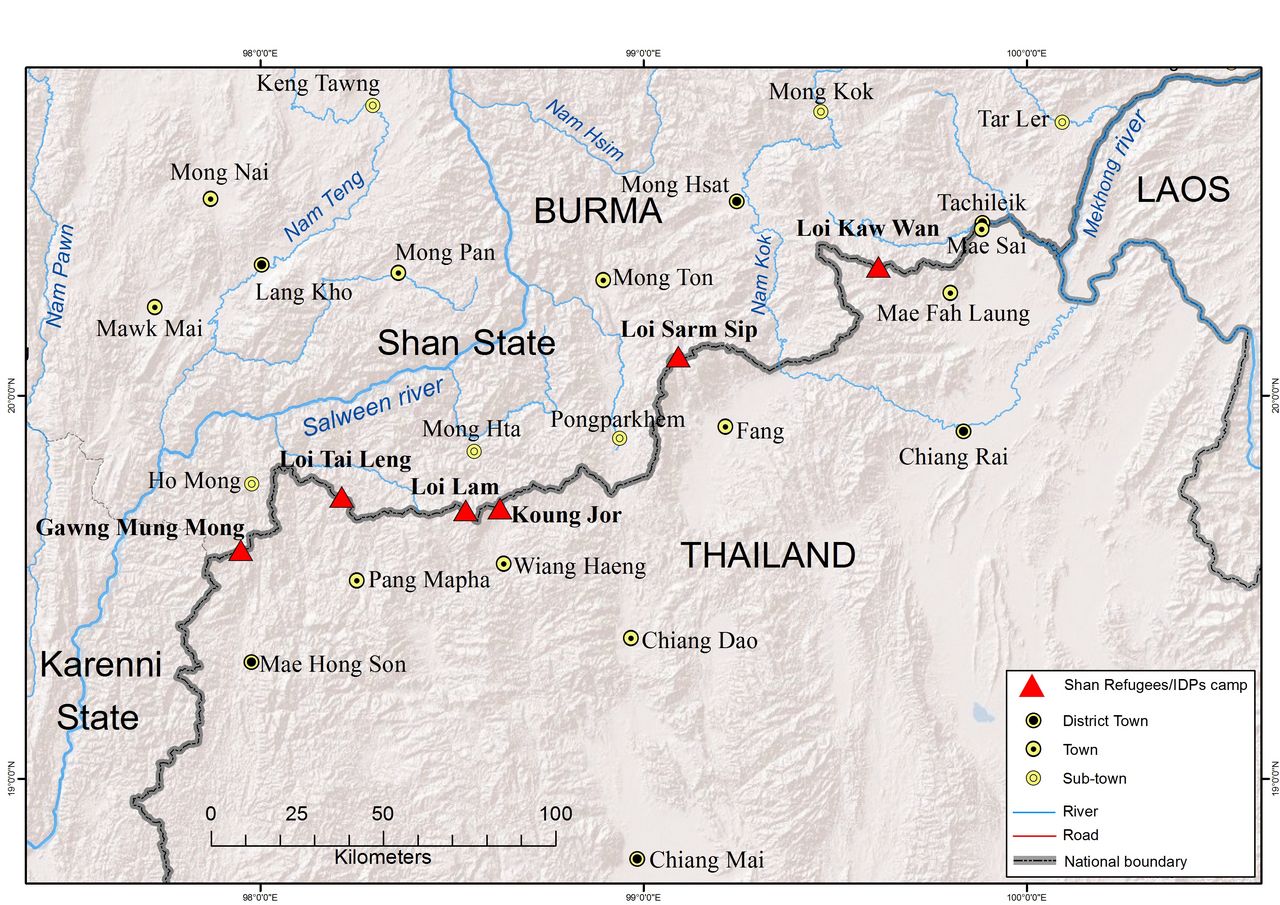
Contents
Summary
Background of displacement from Shan State to Thailand
– The Burma Army’s 1996-1998 scorched earth campaign in central Shan State
– Forced Wa resettlement to southern Shan State (1999-2001)
Background and current situation of IDP and refugee camps on the Thai-Shan border
– Current camp populations
– Setting up of IDP camps on the Thai-Shan border
– Setting up the only Shan refugee camp in Thailand
– Challenges in IDP camps
- Threat of fighting
- Little cultivable land, few livelihood opportunities
- Health and education challenges
– Challenges in Koung Jor refugee camp
Reasons why refugees and IDPs are unable to return home
– Ongoing Burma Army expansion in Shan State
– Ongoing attacks and human rights violations by the Burma Army
– Original villages derelict or occupied
– Threat of permanent loss of lands from mega projects
Conclusion
Background of displacement from Shan State to Thailand
Refugees have been fleeing from Shan State to Thailand for decades to escape the civil war and Burma Army persecution, but did not flee in large numbers until the 1990s. This was unlike refugees from Karen, Karenni and Mon States, who have been fleeing in the tens of thousands to Thailand since the 1980s. The first Karen refugee camps were set up in Thailand in 1984. After 1988, refugee camps were set up for the Mon and Karenni.
Two key factors caused the numbers of refugees from Shan State to increase dramatically in the late 1990s: a massive scorched earth campaign by the Burma Army in central Shan State beginning in 1996, and the forced resettlement of Wa villagers from northern to southern Shan State beginning in 1999.
The Burma Army’s 1996-1998 scorched earth campaign in central Shan State
After the surrender of the Mong Tai Army at the end of 1995, MTA remnants, led by Lt. Gen Yawd Serk, formed a new Shan resistance group, the Shan State Army – South (later called the Restoration Council of Shan State/Shan State Army – RCSS/SSA). In March 1996, in an attempt to cut off support for this new group, the Burma Army began a massive scorched-earth operation in central Shan State, driving the rural population at gunpoint off their lands into guarded resettlement camps near towns and main roads.
The results of this operation were devastating. During 1996-1998, over 300,000 people from 1,400 villages were forced from their homes. Those resisting or caught sneaking back to their fields were shot on sight or tortured by Burma Army troops. SHRF documented the killing of over 600 civilians during this time, including the well-known massacre of 56 villagers, including women, in Kunhing, on June 16, 1997. These villagers had been given permission to travel by ox-cart to collect rice from their old villages, but were arrested and shot dead by Burma Army troops on the way.
There was also widespread use of rape as a weapon of war. The 2002 report by SHRF and SWAN, Licence to Rape, documented rape and other forms of sexual violence against 625 women and girls by troops from 52 different Burma Army battalions, mostly in the areas of forced relocation in Shan State. 61% of the women were gang-raped. 25% were killed, some horribly mutilated.
Terrorized by these atrocities, and unable to survive in the relocation sites, many of the relocated villagers fled to Thailand. Entire families, including elderly grandparents and young children, fled together, using any means – trekking through the jungle, rafting along the Salween River and renting cars — to reach the border.
By May 1996, tens of thousands of villagers had fled into northern Thailand, mainly dispersing into farms and orchards to find work as laborers or wait for the chance to move to construction sites in towns such as Chiang Mai. As illegal migrants, the refugees were vulnerable at all times to arrest and deportation, as well as exploitation by unscrupulous brokers and employers. Too afraid to venture from their worksites, some refugees died of treatable illnesses. Children had no access to schooling and faced health and safety threats from living in crowded, unsanitary work sites, often exposed to harmful chemical pesticides.
Shan community groups made repeated efforts to advocate to the Thai authorities to set up refugee camps for the Shan, as on the Karen and Karenni borders, but to no avail. Thai officials insisted that the huge Shan refugee influx were just “seasonal migrants.”
Despite the lack of guarantees of protection in Thailand, refugees continued to flee in desperation from central Shan State. By April 1998, SHRF estimated that at least 80,000 villagers had fled from the areas of forced relocation to Thailand.
Forced Wa resettlement to southern Shan State (1999-2001)
In late 1999, the Burmese military regime authorized the UWSA, which had signed a ceasefire agreement since 1989, to begin mass forced resettlement of Wa villagers from the Chinese border down to southern Shan State.
The pretext for the resettlement was drug eradication: to move Wa villagers from the mountainous poppy-growing regions in the north down to more fertile farmlands along the Thai border, where they could grow alternative crops. The real reason was political: using ongoing divide and rule tactics, the regime wanted to pit the UWSA against the RCSS/SSA, and weaken Shan resistance in southern Shan State.
Between 1999 and 2001, over 126,000 villagers – about a quarter of the total Wa population in Burma — were forcibly relocated from the six northern Wa townships down to the townships of Tachileik, Mong Hsat and Mong Ton along the Thai border. The move inflicted huge suffering on the Wa villagers, who were forced to abandon their homes and possessions in the north. Diseases were rife in the resettlement sites and thousands died. (LNDO report 2002)
The large influx of new settlers caused severe disruption for existing villages – mainly Shan, Lahu and Akha – in southern Shan State. Houses, land, crops and livestock were seized without compensation, and in some areas UWSA started taxing and conscripting local villagers. Thousands of local villagers could not bear this oppression and fled to other areas of Shan State or to Thailand.
Over 16,000 Wa were resettled in the Mong Karn area along the Nam Sai river in eastern Mong Hsat, where there were originally six villages, with about 1,200 inhabitants, who were mostly Shan. When heavy fighting broke out between the RCSS/SSA and Burma Army near this area in early 2001, the Burma Army and UWSA began persecuting Shan villagers suspected of supporting the Shan troops. Hundreds of Shan villagers from Mong Karn fled to the Thai border, where they set up the Loi Kaw Wan IDP camp. The original homes and lands of the Mong Karn inhabitants have now all been seized by the UWSA.
Background and current situation of IDP and refugee camps
The current populations in the IDP and refugee camps along the Thai-Shan border are as follows (from west to east):
| No. | Camp name | Year
set up |
Location
(Thai district/sub-district, province) |
Current population | |||
| m | f | Total | % under 18 | ||||
| 1 | Kong Moong Murng
(IDP camp) |
2007 | Opposite Mok Cham Pae, Mae Hong Son province | 119 | 127 | 246 | 41% |
| 2 | Loi Tai Laeng
(IDP camp) |
1999 | Opposite Bang Ma Pha, Mae Hong Son province | 1,130 | 1,179 | 2,309 | 52% |
| 3 | Loi Lam
(IDP camp) |
2006 | Opposite Wiang Haeng, Chiang Mai province | 121 | 117 | 238 | 37% |
| 4 | Koung Jor
(refugee camp) |
2002 | Wiang Haeng, Chiang Mai province | 192 | 210 | 402 | 40% |
| 5 | Loi Sam Sip
(IDP camp) |
2006 | Opposite Fang, Chiang Mai province | 208 | 148 | 356 | 32% |
| 6 | Loi Kaw Wan
(IDP camp) |
2001 | Opposite Mae Fah Luang, Chiang Rai province | 1,246 | 1,388 | 2,634 | 34% |
| Overall total | 3,016 | 3,169 | 6,185 | 39% | |||
The refugees and IDPs in the camps are of various ethnicities, including Shan, Lahu, Akha, Wa, Ta’ang, Pa-Oh, Lisu, Karen and Chinese. Each camp is managed by a camp committee, comprised of refugees/IDPs, including those who were formerly village or community leaders in their original villages.
International donors have been providing food aid to these camps since they were set up. Later, some agencies provided short-term health and education support.
Setting up of IDP camps on the Thai-Shan border
The first IDP camp on the Thai-Shan border was set up in 1999, opposite northern Mae Hong Son province. 35 families who had fled from the forced relocation in central Shan State, set up camp on the Thai side of the border. Within two weeks they were forced by the Thai authorities to relocate to the border line, where they sought the protection of the RCSS/SSA, which had just set up its headquarters on a mountain ridge at Loi Tai Laeng. After the camp was set up, and a school and health centre established, more IDP families came to seek refuge there. Orphans and vulnerable children were also sent from conflict areas inside Shan State to be taken care of and receive schooling.
Subsequent IDP camps followed a similar pattern, whereby fleeing IDP families first tried to stay on the Thai side of the border, but ended up seeking refuge under the protection of the RCSS/SSA just inside the Shan border.
In 2001, about 500 refugees fleeing from Burma Army abuses and Wa resettlement in Mong Karn, eastern Mong Hsat, set up camp in fields inside the border at Mae Fah Lung district of northern Chiang Rai province. Within one month, they were forced back across the border, where they set up camp under the protection of the RCSS/SSA.
Unfortunately, even after the IDPs had relocated back to the border line, they were sometimes again forced by the Thai authorities to dismantle sections of their camps protruding into Thailand. In 2006, a section of Loi Tai Laeng housing 68 refugee families, the school, children’s dormitories, temple and clinic, which were just inside the Thai border, were demolished and had to be rebuilt on the Shan side. At Loi Kaw Wan IDP camp, in 2009, about 20 houses, including a school building, which jutted into Thailand, were similarly dismantled.
In 2007, 24 IDP families in Loi Sam Sip were forced to move their houses deeper inside Shan State “out of sight of the border,” even though they were already on the Shan side of the border.
Setting up the only Shan refugee camp in Thailand
In early 1996, after the surrender of the MTA, several villages in the former MTA liberated area opposite Wiang Haeng district of northern Chiang Mai province, came under Burmese government control.
In 2002, there was heavy fighting between the Burma Army and SSA-S in this border area. The Burma Army suspected the villagers living close to the border of supporting the Shan troops, and shelled directly into the villages, killing one and injuring twelve civilians. Five villagers, including a 12-year-old boy, were killed. One villager was cut into three pieces. The entire population of the four villages close to the border therefore fled into Thailand and took shelter in several temples in the Wiang Haeng area. All the villagers’ possessions, including motorbikes, trucks, iron roofing and domestic animals were looted by the Burma Army,
In 2003, the refugees relocated to the grounds of the Wat Fah Wieng Inn temple, where they were allowed by the Thai authorities to set up a temporary camp, called Koung Jor. They were able to receive humanitarian aid from international agencies, but the UNHCR was not permitted to register the refugees. Therefore, unlike the Karen, Karenni and Mon refugees, the Koung Jor refugees were never eligible for third country resettlement.
Challenges in IDP camps
The IDPs face many challenges to survive on the remote mountain ridges where the camps are located, as most originally lived in lowland valleys.
– Vulnerability to attack
The IDP camps are all located on small slivers of territory controlled by the RCSS/SSA. On the Shan side of the border, they are surrounded by military camps belonging to the Burma Army, government militia or UWSA. Fighting has taken place near several IDP camps, threatening the lives of the IDPs.
In 2002, there was a fierce offensive by the Burma Army, UWSA and government militia against the RCSS/SSA near Loi Kaw Wan camp, where IDP houses were in shelling range of Burma Army artillery.
In 2005, the UWSA launched an attack against the RCSS/SSA east of Loi Tai Laeng. Thousands of shells landed in and around the camp, forcing IDPs to shelter in bunkers from the shelling.
As trust in the ceasefire process decreases, the IDPs are becoming fearful they may face such attacks again.
– Little cultivable land, few livelihood opportunities
Water resources are scarce, and there is very little cultivable land on the mountaintop areas around the IDP camps. IDPs are unable to venture deeper into Shan State to do farming due to the Burma Army and UWSA camps. The IDPs can grow a few vegetables near their houses, and there are a few hill fields close to some camps, but it is not possible for the IDPs to grow enough rice to be self-sustaining.
IDPs in some of the camps can cross into Thailand to do daily wage labour, usually in farms. However, such jobs are seasonal, and poorly paid. In the more remote camps, there is no wage labour available at all nearby.
– Insufficient funds for health and education
Health centres have been set up in each of the camps, which are staffed by local medics and community health workers. These personnel provide basic health care and health education, but refer all serious cases to hospitals in Thailand, up to a day’s drive away. The transport and medical costs are a huge burden for the camps. In Loi Kaw Wan, three women who developed complications in labor have died because they were unable to be transferred to a Thai hospital in time.
Shan national schools have been set up in each camp, attended not only by IDP children, but also orphaned and disadvantaged children who have been sent from different areas of Shan State to be taken care of at the schools. The Loi Tai Laeng school currently has over 700 students. Apart from needing to provide sufficient nutritious food for these children, it is a challenge to find funds to support the teachers, buy school materials, and carry out teaching training and curriculum development.
| No. | IDP camp | Schools | No. of students | No. of teachers |
| 1 | Kong Moong Merng | 1 | 45 | 4 |
| 2 | Loi Tai Laeng | 1 | 710 | 48 |
| 3 | Loi Lam | 1 | 39 | 2 |
| 4 | Loi Sam Sip | 1 | 20 | 2 |
| 5 | Loi Kaw Wan | 1 | 219 | 9 |
| TOTAL | 5 | 1,033 | 65 |
Challenges in Koung Jor refugee camp
Refugees in Koung Jor camp face similar difficulties to IDPs in having no land of their own to cultivate. They are not allowed to work outside the camp. Refugees needing medical treatment have to go to the Thai hospital at Wiang Haeng, about one hour’s drive away. Children have to travel by truck outside the camp to attend Thai schools.
Reasons why refugees and IDPs are unable to return home
Since the start of the peace process in 2011, when ethnic armed groups began signing new or renewed bilateral ceasefires with the Burma Army, international donors have been cutting aid to refugees along the Thai-Burma border.
However, even though the RCSS/SSA signed a bilateral ceasefire with the Burmese government in December 2011, and also signed the Nationwide Ceasefire Agreement in October 2015, refugees and IDPs in camps along the Shan-Thai border are not yet able to return home, for various reasons.
- 1.Ongoing Burma Army expansion in Shan State
Since the 1996-1998 forced relocation in central Shan State, the numbers of Burma Army troops have expanded hugely in the relocated areas.
Maps showing increase from 10 to 30 Burma Army battalions during 1996-2006 near the planned Mong Ton dam on the Salween river, from Shan Sapawa’s 2006 report, Warning Signs
In 2011 the Burma Army set up its 14th Regional Command – the Central Eastern Command – in Kho Lam, Namzarng township, right in the centre of the 1996-1998 forced relocation area. Formerly a small village, with one Burma Army battalion, Kho Lam has become a huge military installation, with 27 battalions.
Even though in the RCSS/SSA’s January 2012 union-level ceasefire agreement, it was stated that the RCSS/SSA would be allowed to set up its headquarters in Ho Mong and Mong Hta sub-townships (in southern Langkho township), the Burma Army has not pulled back any troops from these areas. As a result, the RCSS/SSA has maintained its headquarters at Loi Tai Laeng.
- Ongoing attacks and human rights violations by the Burma Army
Despite the ceasefire agreements signed by the RCSS/SSA and the Shan State Progressive Party/Shan State Army (SSPP/SSA) since 2011, the Burma Army has launched hundreds of attacks against both groups. Even after the RCSS/SSA signed the Nationwide Ceasefire Agreement in 2015, fighting with the Burma Army has continued, most recently in Ho Pong, Mong Paeng and Mong Kung townships.
The Burma Army has also continued to commit gross human rights violations against civilians in ceasefire areas, including extrajudicial killing, torture, and sexual violence. Since July 2017, there has been a large-scale military operation in Ho Pong, where troops from at least eight Burma Army battalions have tortured and arrested scores of villagers.
- 3.Original villages lie derelict or have been occupied
Hundreds of the over 1,400 villages forcibly relocated by the Burma Army during 1996-1998 no longer exist, as villagers have not dared go back to inhabit them. Houses and temples have fallen derelict, and lands are either overgrown or have been taken over by the Burma Army and their allied militia.
For example, the township of Mong Nai – one of eleven townships where forced relocation took place — used to have a total of 224 villages before 1996. Today, according to official township immigration lists, only 83 villages remain (of which 27 are “new” villages). 141 villages have been completely erased.
For IDPs who fled from areas of Wa resettlement in eastern Mong Hsat, their original homes are now occupied by Wa settlers. The former Shan villages in the Mong Karn valley have now all been completely taken over by the UWSA.
- 4.Threat of permanent loss of lands from megaprojects
Refugees from areas where the Burmese government has planned large hydropower dams or mining projects will lose their homes forever if these projects go ahead.
For example, the giant Mong Ton dam on the Salween River, a joint venture with Thai and Chinese companies for export of power to Thailand, will submerge vast tracts of land along the Pang tributary in Kunhing township. Nearly 50,000 people were forcibly relocated from this area in 1996-1998. If the dam goes ahead, many will never be able to return home.
Similarly the large lignite mine and coal fired power plant project planned by the Burmese military-owned Myanmar Economic Corporation and Italian-Thai Power Company in Mong Kok, Mong Hsat township, will make the entire tract, with over 1,000 Shan, Lahu and Akha residents, uninhabitable. IDPs in Loi Kaw Wan camp who fled Burma Army persecution in Mong Kok, will be unable to return home if this project goes ahead. The project has been stalled for about six years as a result of protests from the Thai side of the border (due to potential pollution of the Kok River, one of northern Thailand’s main waterways.) However, since August 2017, the project has resumed, and villagers have been ordered out of the mining area.
Conclusion
Despite the peace process, it is still impossible for the displaced villagers in camps along the Thai-Shan border to return home. The Burma Army has not adhered to its ceasefire agreements with the RCSS/SSA, and has continued its military expansion and operations throughout southern Shan State. Civilians continue to face systematic abuse.
Hundreds of the original villages of the refugees have either now fallen derelict, or are occupied by the Burma Army, government militia or UWSA.
Unless there is a genuine nationwide ceasefire, withdrawal of Burma Army troops, and a political settlement with the ethnic armed stakeholders, the displaced villagers dare not return home.
Until such time as the refugees can return voluntarily, in safety and dignity, international donors are urged to maintain adequate humanitarian support for the refugee and IDP camps along the Shan-Thai border.
Contact persons:
Shan State Refugee Committee (Thai Border)
Lung Sai Lieng + 66: (0) 86-188-9827
Lung Sai Pieng + 66: (0) 82-181-4891
Lung Sai + 66: (0) 97-939-8350 +95 (0) 94-232-88790
Nang Hseng Ing + 66: (0) 97-968-9572
Shan Human Rights Foundation
Contact:
Nang Charm Tong +66: (0) 81-603-6655
Sai Hor Hseng +66: (0) 62-941-9600
Sai Korn Lieo +66: (0) 94-643-4230
Urgent Appeal
PDF files>>>> Shan| Burmese| English| Thai
SHRF Update
PDF files:>>> Shan| Burmese| English| Thai
This article originally appeared on SHRF on August 30, 2017.

